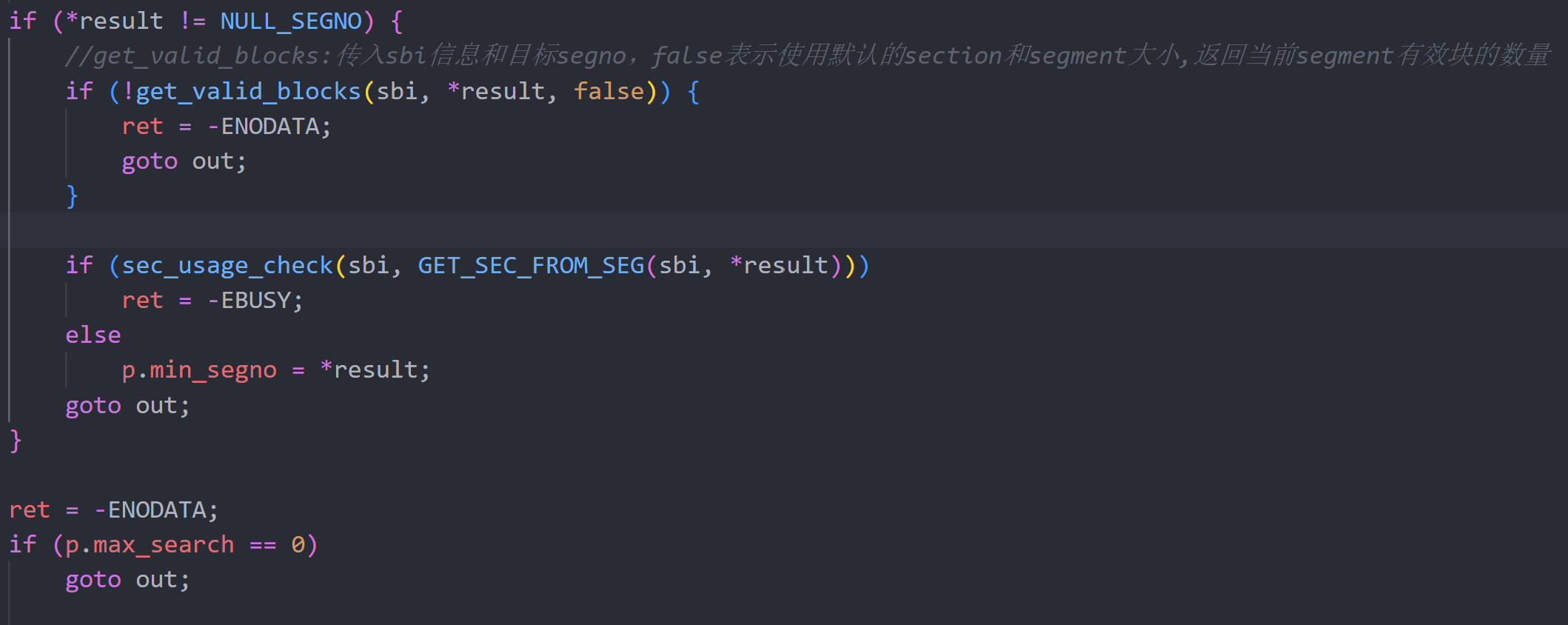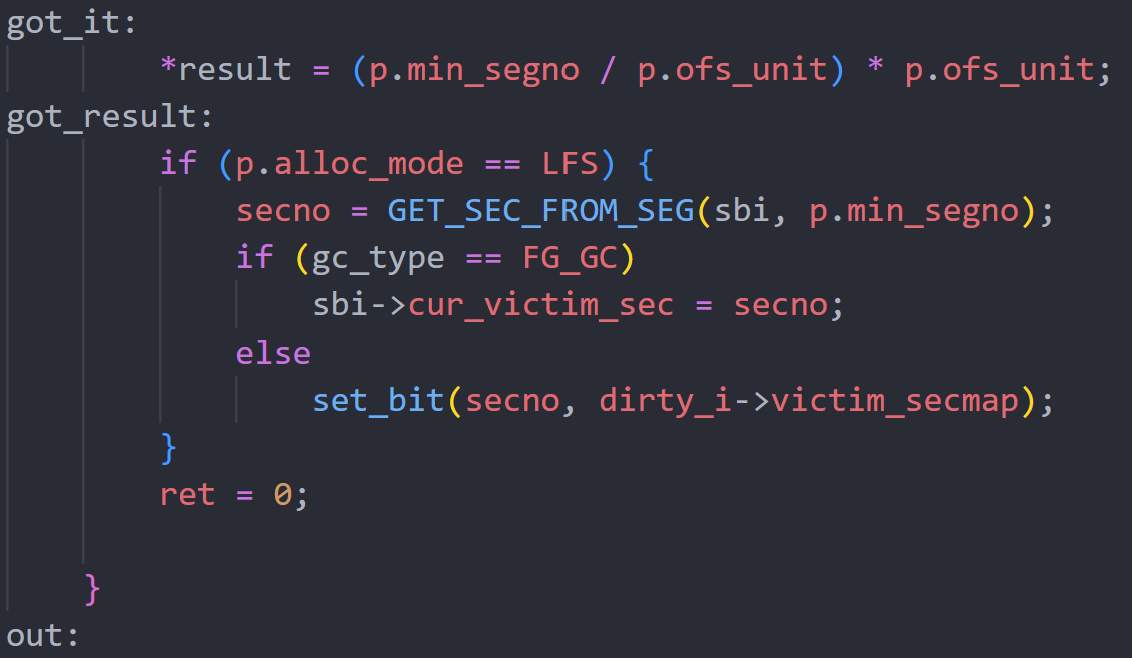由于Log-Structured结构,F2FS文件系统的可用空间会快速被消耗,因此需要引入垃圾回收(GC)来回收空间。
本源码阅读主要为个人阅读F2FS GC源码过程中的记录,主要介绍以下内容。
- 介绍f2fs gc的主体流程
- 【当前】介绍victim segment选择策略(涉及一定的SSR机制相关的内容)
- 介绍GC的执行过程
在每部分内容中,会对涉及的关键数据结构进行阅读与记录,并分析函数的执行流程与若干细节。
f2fs_get_victim函数(选择victim segment的核心函数)
在空间不足时,F2FS会进行GC操作来腾出空闲空间。
segment(默认情况下为2MB,包含512个block)是F2FS GC的基本单位。在实际进行有效块的识别和迁移之前,首先需要使用victim segment选择策略找到GC收益/性价比最高的segment,从而进行数据迁移与segment的回收。
函数f2fs_get_victim是实现上述victim segment selection的关键函数。后来,由于SSR机制的引入、以及SSR机制在segment的选取逻辑上与F2FS GC选取逻辑上有着相近之处,因此该函数还同时被用于SSR目标segment的选取。
1. 涉及的关键结构体
1.1 结构体victim_sel_policy:设定GC策略 (fs/f2fs/segment.h)
/* for a function parameter to select a victim segment */
struct victim_sel_policy {
int alloc_mode; /* LFS or SSR */
int gc_mode; /* GC_CB or GC_GREEDY */
unsigned long *dirty_bitmap; /* dirty segment/section bitmap */
unsigned int max_search; /*
* maximum # of segments/sections
* to search
*/
unsigned int offset; /* last scanned bitmap offset */
unsigned int ofs_unit; /* bitmap search unit */
unsigned int min_cost; /* minimum cost */
unsigned long long oldest_age; /* oldest age of segments having the same min cost */
unsigned int min_segno; /* segment # having min. cost */
unsigned long long age; /* mtime of GCed section*/
unsigned long long age_threshold;/* age threshold */
};
-
alloc_mode:分配器策略,支持LFS或者SSR(还有AT_SSR,若有需要再补充)。
LFS是GC选择待待回收segment场景,而SSR是SSR分配策略选择segment的场景。
-
gc_mode:本次GC的策略,常见有GC_CB和GC_GREEDY两种
-
dirty_bitmap:对应segment管理的dirty_segmap字段,一共有8中类型的脏数据,
-
DIRTY_HOT/WARM/COLD_DATA和DIRTY_HOT/WARM/COLD_NODE类型用于SSR分配场景;
- DIRTY:更多用于GC场景
- PRE表示没有可用block的segment,等待CP流程将其释放。
-
-
max_search、offset:最多搜索次数和上次搜索后的偏移值,用于搜索dirty_bitmap中的内容。
-
min_cost:最小开销,用于上述两种GC策略的比较。
-
min_segno:根据GC策略选择的最小segment号。
-
ofs_unit:bitmap search unit,遍历单位。LFS模式下用sbi->segs_per_sec赋值(默认为1),SSR模式下直接赋1
1.2 结构体:f2fs_sb_info:最常用的super block信息结构体(fs/f2fs/f2fs.h)
struct f2fs_sb_info {//(暂时仅列出用于GC的成员)
struct dirty_seglist_info *dirty_info; /* dirty segment information,*/
// GC时,根据情况给结构体victim_sel_policy的dirty_bitmap赋值
...
/* for cleaning operations */
struct f2fs_rwsem gc_lock; /*
* semaphore for GC, avoid
* race between GC and GC or CP
*/
struct f2fs_gc_kthread *gc_thread; /* GC thread */
struct atgc_management am; /* atgc management */
unsigned int cur_victim_sec; /* current victim section num */
unsigned int gc_mode; /* current GC state */
unsigned int next_victim_seg[2]; /* next segment in victim section */
spinlock_t gc_remaining_trials_lock;
/* remaining trial count for GC_URGENT_* and GC_IDLE_* */
unsigned int gc_remaining_trials;
...
}
2. f2fs_get_victim函数
f2fs_get_victim函数有两种调用方式:GC 和 SSR segment selection
- GC:选择victim segment,且不从victim seglist中移除
- SSR:选择含有最少valid blocks数量的segment,并从victim seglist中移除
下面介绍该函数的执行过程,若只想关注总体流程,可直接跳转至总结。
-
设定结构体
victim_sel_policy p -
设定p的初始值
调用函数
select_policy(传入sbi、gc_type、type、victim_sel_policy结构体&p)函数作用:设置p的gc_mode(GC策略)、max_search(最多搜索次数)、dirty_bitmap、offset(victim semgent的bitmap offset)等参数
-
根据
alloc mode进行相关设置-
alloc_mode为SSR时,将gc_mode设置为GC_GREEDY,将搜索范围max_search设置为整个dirty seglist
-
alloc_mode为AT_SSR时,策略同SSR
-
alloc_mode为LFS时,根据gc_type得到GC mode
此处留了一些接口,若segment和section大小发生变化时会发生些许变化。
默认情况下,该函数的max_search也设置为整个dirty seglist
-
-
调整
max_search范围仅在BG_GC、gc_mode非URGENT、GC_AT、AT_SSR等模式下时进行如下设置
max_search=min(max_search, sbi->max_victim_search) -
设置结构体p的offset (bitmap offset),在dirty bitmap中遍历寻找victim segment的起始偏移量
-
mount_opt.fs_mode为
FS_MODE_FRAGMENT_SEG或FS_MODE_FRAGMENT_BLK时bitmap offset设置为随机数
-
mount_opt.opt为NOHEAP模式时,且类型为directory entry blocks或node blocks时
bitmap offset设置为0
-
否则将bitmap设置为同样gc_mode的上一次处理到的victim segment的偏移位置
if (f2fs_need_rand_seg(sbi))//判断条件;m p->offset = prandom_u32_max(MAIN_SECS(sbi) * sbi->segs_per_sec); //随机指定到当前section中的某个偏移量 else if (test_opt(sbi, NOHEAP) && (type == CURSEG_HOT_DATA || IS_NODESEG(type))) p->offset = 0; else p->offset = SIT_I(sbi)->last_victim[p->gc_mode]; -
-
-
选取victim segment(p.min_segno存储当前策略下选取的victim segno)

-
result(目标回收的segno)已经指定的情况下,判断当前result是否可用(一般仅在ioctl场景会使用)
(需要包含有效块,且不为当前正在处理的curseg队列中,且不是当前已选择的victim segment)
-
result未指定
-
p.max_search为0,达到搜索边界,退出
-
若当前为FG_GC,且alloc_mode为LFS(非SSR模式)则能够使用上次BG_GC选取的segment
原因可能是因为需要加快速度,快速得到使用空间,直接使用上次未完成的BGGC的选取结果,存储到p.min_segno中,并跳转至
got_it。 -
若上述步骤都无法找到合适的victim segment,则真正开始通过dirty bitmap遍历查找,通过
find_next_bit找到dirty bitmap中合适的segno该遍历方式为循环单向遍历,从当前
p.offset开始,若遍历至bitmap尾,则从头开始继续遍历,直到遍历一圈。 -
根据alloc_mode进行条件判断
-
LFS模式下:若该segment含有上次cp过的有效块,则跳过目前segment,继续循环遍历
(Dont touch checkpointed data)
-
SSR模式下:若当前segment已经没有空闲块,则跳过目前segment,继续循环遍历
判断条件:
!f2fs_segment_has_free_slot(sbi, segno)
-
-
根据gc_type进行条件判断
- BGGC:若当前segment已在BGC victims中,则跳过
- FGGC:若为pinned segment,则跳过
- ATGC:暂略
-
若通过了4、5的条件判断,则表明当前segno有效
计算当前segno在当前gc策略下的cost(
get_gc_cost),更新p.min_segno、p.min_cost等信息 -
若已经达到搜索边界,则更新
p->last_victim[p.gc_mode]信息,并退出循环
-
-
-
got_it (got_result):找到了victim segno,将结果存到result中,并修改sbi->cur_victim_sec、dirty_seglist_info中对应的信息

总结:f2fs_get_victim函数的总体流程如下:
-
若当前是FG_GC时,则尽量不进入循环搜索,直接使用BG_GC的选取结果(为了加快选取速度)
-
开始进入循环搜索。
- 首先根据
find_next_bit函数,从p.dirty_segmap中找到第一个dirty的segment出来(搜索方式为单向循环搜索)。 - 然后,对该segment进行若干条件判断
- GC模式下,要求其不能包含上一次刚CP过的有效块
- SSR模式下,要求其不能不含空闲块
- 经过条件判断后,通过
get_gc_cost函数计算segment的cost,并判断是否小于p.min_cost,然后进行赋值
循环在达到了最大的搜索次数之后退出,
*result存储了选取的segno。 - 首先根据
3. get_gc_cost函数
F2FS中,通过变量cost来表示开销。在进行层层segment可用性筛选后,再对这些经过筛选的segment进行cost的计算,从而选择最佳的segment。由于SSR机制与F2FS GC由于逻辑相近,因此共用f2fs_get_victim接口,只需在计算cost阶段修改相应的逻辑即可。
-
F2FS GC模式:常见的victim segment选择策略如下:
-
前台GC:采用greedy policy,选取有效块最少的section
-
后台GC:采用cost-benefit策略,根据利用率以及”age“来选择victim section
算法:cost_benefit = (1-u)/2u*age,结果越大,越值得cleaning u表示valid block 在该section中的比例 1-u表示无效块的比例,即GC收益。 2u表示对这个section进行GC的开销(读取Valid block(1个u)并写到新的segment中(1个u) age表示上一次修改距离现在的时间差
-
-
SSR模式:segment有效块最多,cost越大,越不会选取该segment
因为SSR模式下,系统希望选取的segment中包含的无效块/空闲块越多越好(即有效块越少越好),这样就有更多的空间提供新数据的覆盖写入。
static inline unsigned int get_gc_cost(struct f2fs_sb_info *sbi,
unsigned int segno, struct victim_sel_policy *p)
{
if (p->alloc_mode == SSR)
return get_seg_entry(sbi, segno)->ckpt_valid_blocks;
/* alloc_mode == LFS */
if (p->gc_mode == GC_GREEDY)
return get_valid_blocks(sbi, segno, sbi->segs_per_sec); // Greedy算法,valid block越多表示cost越大,越不值得gc
else
return get_cb_cost(sbi, segno); // Cost-Benefit算法,这个是考虑了访问时间和valid block开销的算法
}
源码 f2fs_get_victim
/*
* This function is called from two paths.
* One is garbage collection and the other is SSR segment selection.
* When it is called during GC, it just gets a victim segment
* and it does not remove it from dirty seglist.
* When it is called from SSR segment selection, it finds a segment
* which has minimum valid blocks and removes it from dirty seglist.
*/
int f2fs_get_victim(struct f2fs_sb_info *sbi, unsigned int *result,
int gc_type, int type, char alloc_mode,
unsigned long long age)
{
struct dirty_seglist_info *dirty_i = DIRTY_I(sbi);
struct sit_info *sm = SIT_I(sbi);
struct victim_sel_policy p;
unsigned int secno, last_victim;
unsigned int last_segment;
unsigned int nsearched;
bool is_atgc;
int ret = 0;
mutex_lock(&dirty_i->seglist_lock);
last_segment = MAIN_SECS(sbi) * sbi->segs_per_sec;
p.alloc_mode = alloc_mode;
p.age = age;
p.age_threshold = sbi->am.age_threshold;
retry:
select_policy(sbi, gc_type, type, &p);
p.min_segno = NULL_SEGNO;
p.oldest_age = 0;
p.min_cost = get_max_cost(sbi, &p);
is_atgc = (p.gc_mode == GC_AT || p.alloc_mode == AT_SSR);
nsearched = 0;
if (is_atgc)
SIT_I(sbi)->dirty_min_mtime = ULLONG_MAX;
if (*result != NULL_SEGNO) {
if (!get_valid_blocks(sbi, *result, false)) {
ret = -ENODATA;
goto out;
}
if (sec_usage_check(sbi, GET_SEC_FROM_SEG(sbi, *result)))
ret = -EBUSY;
else
p.min_segno = *result;
goto out;
}
ret = -ENODATA;
if (p.max_search == 0)
goto out;
if (__is_large_section(sbi) && p.alloc_mode == LFS) {
if (sbi->next_victim_seg[BG_GC] != NULL_SEGNO) {
p.min_segno = sbi->next_victim_seg[BG_GC];
*result = p.min_segno;
sbi->next_victim_seg[BG_GC] = NULL_SEGNO;
goto got_result;
}
if (gc_type == FG_GC &&
sbi->next_victim_seg[FG_GC] != NULL_SEGNO) {
p.min_segno = sbi->next_victim_seg[FG_GC];
*result = p.min_segno;
sbi->next_victim_seg[FG_GC] = NULL_SEGNO;
goto got_result;
}
}
last_victim = sm->last_victim[p.gc_mode];
if (p.alloc_mode == LFS && gc_type == FG_GC) {
p.min_segno = check_bg_victims(sbi);
if (p.min_segno != NULL_SEGNO)
goto got_it;
}
while (1) {
unsigned long cost, *dirty_bitmap;
unsigned int unit_no, segno;
dirty_bitmap = p.dirty_bitmap;
unit_no = find_next_bit(dirty_bitmap,
last_segment / p.ofs_unit,
p.offset / p.ofs_unit);
segno = unit_no * p.ofs_unit;
if (segno >= last_segment) {
if (sm->last_victim[p.gc_mode]) {
last_segment =
sm->last_victim[p.gc_mode];
sm->last_victim[p.gc_mode] = 0;
p.offset = 0;
continue;
}
break;
}
p.offset = segno + p.ofs_unit;
nsearched++;
#ifdef CONFIG_F2FS_CHECK_FS
/*
* skip selecting the invalid segno (that is failed due to block
* validity check failure during GC) to avoid endless GC loop in
* such cases.
*/
if (test_bit(segno, sm->invalid_segmap))
goto next;
#endif
secno = GET_SEC_FROM_SEG(sbi, segno);
if (sec_usage_check(sbi, secno))
goto next;
/* Don't touch checkpointed data */
if (unlikely(is_sbi_flag_set(sbi, SBI_CP_DISABLED))) {
if (p.alloc_mode == LFS) {
/*
* LFS is set to find source section during GC.
* The victim should have no checkpointed data.
*/
if (get_ckpt_valid_blocks(sbi, segno, true))
goto next;
} else {
/*
* SSR | AT_SSR are set to find target segment
* for writes which can be full by checkpointed
* and newly written blocks.
*/
if (!f2fs_segment_has_free_slot(sbi, segno))
goto next;
}
}
if (gc_type == BG_GC && test_bit(secno, dirty_i->victim_secmap))
goto next;
if (gc_type == FG_GC && f2fs_section_is_pinned(dirty_i, secno))
goto next;
if (is_atgc) {
add_victim_entry(sbi, &p, segno);
goto next;
}
cost = get_gc_cost(sbi, segno, &p);
if (p.min_cost > cost) {
p.min_segno = segno;
p.min_cost = cost;
}
next:
if (nsearched >= p.max_search) {
if (!sm->last_victim[p.gc_mode] && segno <= last_victim)
sm->last_victim[p.gc_mode] =
last_victim + p.ofs_unit;
else
sm->last_victim[p.gc_mode] = segno + p.ofs_unit;
sm->last_victim[p.gc_mode] %=
(MAIN_SECS(sbi) * sbi->segs_per_sec);
break;
}
}
/* get victim for GC_AT/AT_SSR */
if (is_atgc) {
lookup_victim_by_age(sbi, &p);
release_victim_entry(sbi);
}
if (is_atgc && p.min_segno == NULL_SEGNO &&
sm->elapsed_time < p.age_threshold) {
p.age_threshold = 0;
goto retry;
}
if (p.min_segno != NULL_SEGNO) {
got_it:
*result = (p.min_segno / p.ofs_unit) * p.ofs_unit;
got_result:
if (p.alloc_mode == LFS) {
secno = GET_SEC_FROM_SEG(sbi, p.min_segno);
if (gc_type == FG_GC)
sbi->cur_victim_sec = secno;
else
set_bit(secno, dirty_i->victim_secmap);
}
ret = 0;
}
out:
if (p.min_segno != NULL_SEGNO)
trace_f2fs_get_victim(sbi->sb, type, gc_type, &p,
sbi->cur_victim_sec,
prefree_segments(sbi), free_segments(sbi));
mutex_unlock(&dirty_i->seglist_lock);
return ret;
}